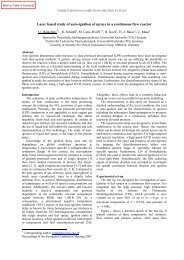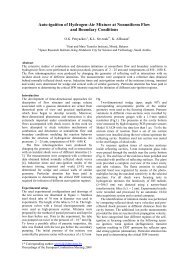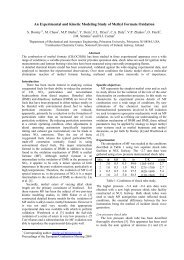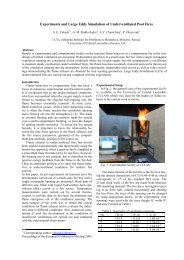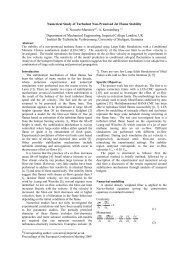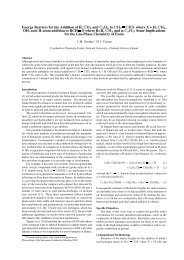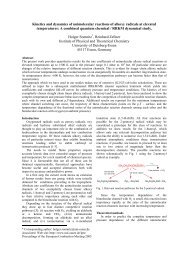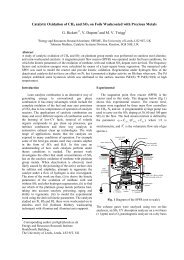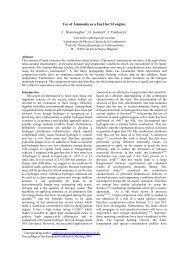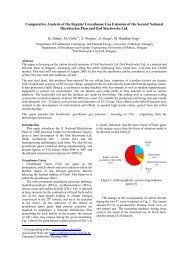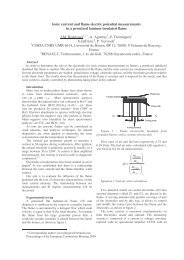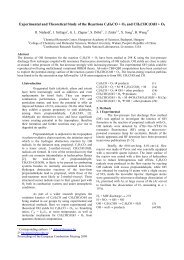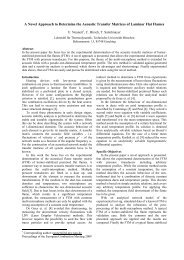Kinetic Modeling of Cyclohexane Oxidation with PAH Formation ...
Kinetic Modeling of Cyclohexane Oxidation with PAH Formation ...
Kinetic Modeling of Cyclohexane Oxidation with PAH Formation ...
You also want an ePaper? Increase the reach of your titles
YUMPU automatically turns print PDFs into web optimized ePapers that Google loves.
<strong>Kinetic</strong> <strong>Modeling</strong> <strong>of</strong> <strong>Cyclohexane</strong> <strong>Oxidation</strong> <strong>with</strong> <strong>PAH</strong> <strong>Formation</strong><br />
N. A. Slavinskaya ∗ , M. Wacker and M. Aigner<br />
IInstitute <strong>of</strong> Combustion Technology, German Aerospace Center (DLR), Stuttgart<br />
Abstract<br />
A skeletal reaction mechanism for low and high temperature cyclohexane oxidation <strong>with</strong> <strong>PAH</strong> formation is<br />
developed. This mechanism is the extension <strong>of</strong> the earlier elaborated reaction model for practical fuels <strong>with</strong><br />
cycloalkane sub model. The important feature <strong>of</strong> this mechanism is its ability to describe the formation <strong>of</strong> benzene<br />
and <strong>PAH</strong> growth. The ignition delay data measured in rapid compressor machine and shock tube experiments are<br />
well reproduced by the model. Experimentally quantified benzene pr<strong>of</strong>ile from RCM is in good agreement <strong>with</strong><br />
model simulations. The modelling results showed dusting temperature dependence <strong>of</strong> dominating reaction routes<br />
leading to aromatics. It is shown that both reaction paths to benzene, via the dehydrogenation <strong>of</strong> cyclohexane and<br />
via recombination <strong>of</strong> small radicals are equally important for temperatures lower 1500K. Only at high temperature,<br />
T > 1500 K, the cyclohexane dehydrogenation is the uniquely dominant way to benzene. The formation <strong>of</strong> large<br />
aromatic molecules can proceed from small radicals, parallel <strong>with</strong> the dehydrogenation <strong>of</strong> cyclohexane.<br />
Introduction<br />
Cycloalkanes (naphthenes) are an important chemical<br />
class <strong>of</strong> hydrocarbons found in diesel (up to 35%),<br />
kerosene (~20%) and gasoline (~10%), which affect the<br />
ignition quality <strong>of</strong> the fuel. Cycloalkanes can raise soot<br />
emission levels because they are known to<br />
dehydrogenate and produce aromatics which can initiate<br />
the chain reaction for the production <strong>of</strong> polycyclic<br />
aromatics to soot formation and growth. In spite <strong>of</strong> its<br />
practical relevance, the chemical kinetics <strong>of</strong> naphthene<br />
pyrolysis and oxidation is not yet thoroughly<br />
investigated. Only the combustion <strong>of</strong> cyclohexane<br />
(CHX, cy-C6H12), the simplest <strong>of</strong> cycloalkanes, has<br />
been investigated in more detail compared to other<br />
cycloalkanes [1-7, 12-17, 20-25].<br />
Generally our aim is to develop a short reaction model<br />
for propylcyclohexane combustion to be included in our<br />
reference fuel model [18]. We start the model<br />
elaboration <strong>with</strong> chemical kinetic mechanism <strong>of</strong> cy-<br />
C6H12 to develop the base reaction model for<br />
cycloalkanes. As the size <strong>of</strong> reaction models for<br />
practical fuels is critical problem, special attention was<br />
devoted to the elaboration <strong>of</strong> the base skeletal model <strong>of</strong><br />
CHX combustion <strong>with</strong> the <strong>PAH</strong> formation.<br />
The presented cy-C6H12 reaction mechanism is based<br />
on a detailed literature analysis [1-17, 19-25]. The<br />
cyclohexane oxidation at high temperatures goes<br />
through several distinct reaction pathways:<br />
unimolecular decomposition <strong>of</strong> cyclohexane leading to<br />
linear products, and H-atom abstraction leading both to<br />
dehydrogenation and formation <strong>of</strong> benzene and to βscission<br />
reactions that break the cyclic ring. At lower<br />
temperatures, addition <strong>of</strong> molecular oxygen to<br />
cyclohexyl radicals followed by internal H-atom<br />
transfer reactions and other<br />
pathways leads to reaction branching and a negative<br />
temperature coefficient (NTC) region similar to those<br />
observed in many n-alkane and iso-alkane hydrocarbon<br />
fuels. Hence, the knowledge about the kinetic <strong>of</strong> CHX<br />
combustion is still poor compared to that about paraffins<br />
∗ Corresponding author: nadja.slavinskaya@dlr.de<br />
Proceedings <strong>of</strong> the European Combustion Meeting 2009<br />
and thus less certain. The published primary reaction<br />
classes and their reference kinetic parameters show<br />
significant discrepancies. Nevertheless, recently<br />
published measurements [4-6, 21-25] can be used for a<br />
further reaction mechanism validation and for the direct<br />
fitting <strong>of</strong> kinetic parameters to global experimental data.<br />
In this paper, we present the skeletal cy-C6H12 reaction<br />
mechanism obtained for modelling <strong>of</strong> the low and<br />
intermediate temperature ignition <strong>of</strong> cyclohexane and on<br />
polycyclic aromatics and soot production in laminar<br />
cyclohexane flame. The prediction <strong>of</strong> this chemistry is<br />
critical for correct simulation <strong>of</strong> ignition in HCCI and<br />
diesel engines.<br />
Previous <strong>Cyclohexane</strong> Studies<br />
One <strong>of</strong> the first studies <strong>of</strong> low temperature <strong>of</strong> cy-C6H12<br />
oxidation was performed by Zeelenberg and Bruijn [1]<br />
which analysed the primary products <strong>of</strong> the slow<br />
oxidation <strong>of</strong> cyclohexane during the induction period at<br />
low temperature and low pressure. Tsang [2] studied the<br />
pyrolysis <strong>of</strong> cyclohexane in a shock tube. The principal<br />
products identified were ethylene, 1,3-butadiene, and 1-<br />
hexene. A further investigation <strong>of</strong> the low temperature<br />
oxidation <strong>with</strong> extensive analyses <strong>of</strong> various reaction<br />
paths was undertaken by Klaï and Baronnet [3]. They<br />
described in their reaction scheme the chain propagation<br />
including the four possible isomers <strong>of</strong><br />
hydroperoxycyclohexyl (cy-C6H10OOH•) radical<br />
formed by isomerisation <strong>of</strong> cyclohexylperoxy (cy-<br />
C6H11OO•) through 4-, 5-, 6-, and 7 – centres<br />
transition states. Decomposition <strong>of</strong> the 4 obtained<br />
hydroperoxycyclohexyl radicals yields cyclohexene,<br />
cyclohexanone, and three bicyclic ethers: 1,2-, 1,3- and<br />
1,4- epoxycyclohexanes, <strong>with</strong> an additional ring<br />
including 3, 4, and 5 members respectively, . The<br />
reaction rates were evaluated <strong>with</strong> thermochemical<br />
methods [23] and modified taking into accont<br />
experimental data measured in [3] for low pressure. In<br />
the investigation [4-7] the reaction schemes <strong>of</strong> high<br />
temperature oxidation were studied. In [4, 5] detailed
eaction mechanisms for cyclohexane oxidation have<br />
been evaluated by comparison <strong>of</strong> computed and<br />
experimental species mole fraction pr<strong>of</strong>iles measured in<br />
a jet-stirred reactor. The major part <strong>of</strong> the reaction rates<br />
<strong>of</strong> the cyclohexane sub mechanism was estimated based<br />
on literature data and analogy <strong>with</strong> small hydrocarbons<br />
or acyclic alkanes. Some reaction rates were evaluated<br />
from global fitting <strong>of</strong> experimental data from these<br />
authors. The mechanism proposed in [6] for the<br />
oxidation <strong>of</strong> cyclohexene at high temperature was build<br />
in a hierarchical and systematic way based on reaction<br />
types used as generic rules; cyclohexene and each<br />
radical are submitted to the different types <strong>of</strong> possible<br />
reactions. These reaction types are those considered in<br />
the high-temperature oxidation <strong>of</strong> alkanes and alkenes<br />
and the radical generation uses the same a priori<br />
simplifications based on the relative reactivity <strong>of</strong> the<br />
species. Literature data, thermochemical kinetic<br />
methods [26], analogy <strong>with</strong> small and linear alkenes and<br />
ignition delay experimental results [6] were used to<br />
determinate the reaction rates.<br />
To model a stoichiometric premixed cyclohexane flame<br />
[23] (p = 30 Torr) a reaction model was generated in [7]<br />
which applies generic rates to some reactions in the<br />
same class while other reaction rates follow mostly from<br />
[8-11]. The generic rates were assigned to reaction<br />
classes <strong>of</strong> hydrogen abstraction, β scission and<br />
isomerisation. The procedure has been successfully<br />
applied to higher paraffins (n-hexane, n-heptane, isooctane,<br />
n-decane, n-dodecane, and n-hexadecane), also<br />
satisfactory results were obtained for describing the<br />
combustion chemistry <strong>of</strong> cyclohexane. Benzene<br />
formation routes through cascading dehydrogenation<br />
and via combination C2-C4 hydrocarbon fragments were<br />
carefully investigated.<br />
Reaction mechanisms which combine high and low<br />
temperature oxidation <strong>of</strong> cy-C6H12 were developed in<br />
[12-15]. In [12] the lumped mechanism <strong>of</strong> the pyrolysis<br />
and oxidation <strong>of</strong> cyclohexane was prepared. The<br />
possible primary elementary reactions <strong>of</strong> high<br />
temperature oxidation are schematically reported<br />
together <strong>with</strong> kinetic parameters directly evaluated on<br />
the basis <strong>of</strong> kinetic parameters <strong>of</strong> the primary pyrolysis<br />
and oxidation reactions <strong>of</strong> linear and branched alkanes.<br />
The kinetic parameters <strong>of</strong> oxygen addition to cyclohexyl<br />
radical (cy-C6H11•), successive isomerisation <strong>of</strong> peroxy<br />
radicals through double rings in the transition state and<br />
reactions <strong>of</strong> intermediate radicals were all evaluated on<br />
the basis <strong>of</strong> the similar reactions <strong>of</strong> alkyl and<br />
alkylperoxy radicals by modifying the corresponding<br />
reference rate constants. The modelling results are<br />
compared <strong>with</strong> different sets <strong>of</strong> measurements. The<br />
results <strong>of</strong> validation confirm the reliability <strong>of</strong> the overall<br />
kinetic model, as well as the validity <strong>of</strong> the lumped<br />
approach. In [13, 14] the mechanism construction was<br />
carried on the base <strong>of</strong> the determination <strong>of</strong> specific rate<br />
constants for reactions <strong>of</strong> other cyclic compounds, such<br />
as branched cyclic alkanes. The paper [13] presents a<br />
modelling study <strong>of</strong> the oxidation <strong>of</strong> cyclohexane from<br />
low to intermediate temperature (650-1050 K) including<br />
2<br />
the negative temperature coefficient (NTC) zone. A<br />
detailed kinetic mechanism has been developed using<br />
computer-aided generation and taking into account all<br />
the possible elementary steps for every isomer <strong>of</strong> peroxy<br />
and hydroperoxy radicals: the model includes 4 isomers<br />
for cy-C6H10OOH• and for cy-OOC6H10OOH•.<br />
Hydroperoxycyclohexyl radicals decompose to 1,2- and<br />
1,4-epoxycylohexane (cyclic ether <strong>with</strong> 3 and 4 ring<br />
size) and other different acyclic molecules. For<br />
cyclohexanol production the authors <strong>of</strong> [13] proposed a<br />
disproportionation reaction <strong>of</strong> two hydroperoxyalkyl<br />
radicals thus omitting the decomposition <strong>of</strong> cy-<br />
C6H10OOH•. The cy-OOC6H10OOH• radicals<br />
decompose to conventional keto hydroperoxide. For the<br />
H-abstraction reactions <strong>of</strong> cy-C6H12 and for reactions<br />
<strong>with</strong> oxygen the literature data for cyclohexane and<br />
analogy <strong>with</strong> n-butane reactions were used. Special care<br />
has been taken to evaluate the rate constants for the<br />
hydroperoxy radical isomerization and the formation <strong>of</strong><br />
cyclic ethers as the ring strengths <strong>of</strong> the respective<br />
transition states are very different from those involved<br />
in reactions <strong>of</strong> linear or branched peroxy radicals. The<br />
corresponding activation energies have been evaluated<br />
from theoretical density function theory and from<br />
thermochemical calculations. A comprehensive<br />
mechanism <strong>of</strong> the oxidation <strong>of</strong> the radicals obtained by<br />
opening <strong>of</strong> the ring has also been included. This<br />
mechanism is able to reproduce satisfactorily<br />
experimental results obtained in a rapid compression<br />
machine, for temperatures ranging from 650 to 900K<br />
and in a jet stirred reactor from 750 to 1050 K.<br />
A detailed chemical kinetic mechanism [14] has been<br />
developed and used to study the oxidation <strong>of</strong><br />
cyclohexane also at both low and high temperatures.<br />
The rates for initiation reactions are mostly analogous to<br />
the rate constant employed in the literature for acyclic<br />
molecules. But for the reaction <strong>of</strong> unimolecular fuel<br />
decomposition, H-atom abstraction by HO2 (assumed<br />
also for abstraction by CH3O2 and cy-C6H10OO•), for<br />
ring opening reaction and alkyl radical isomerisation the<br />
cyclohexane specific rates from literature were adopted.<br />
The principal scheme <strong>of</strong> low temperature sub<br />
mechanism includes 3 isomers <strong>of</strong> peroxycyclohexyl<br />
radical (<strong>with</strong> 5 ,6, and 7 centres in transition state), and<br />
correspond three isomers <strong>of</strong> cy-OOC6H10OOH•. Three<br />
cyclic ethers <strong>with</strong> 3, 4 and 5 ring size are formed from<br />
the cy-C6H10OOH• radicals. The decomposition<br />
pathways <strong>of</strong> each cy-C6H10OOH• radical to form a<br />
multitude <strong>of</strong> other products are carefully considered in<br />
the model [14]. For OOC6H10OOH• decomposition<br />
along <strong>with</strong> ketoperoxyde production the “alternative”<br />
reaction paths were developed, which lead to different<br />
products. The “alternative” decomposition goes through<br />
possible a isomerisation <strong>of</strong> OOC6H10OOH• to 5- , 6- or<br />
7- membered transitions states. Special attention was<br />
devoted to the determination <strong>of</strong> similarities and<br />
differences in the correction terms between cyclic and<br />
acyclic isomerisation reactions in order to establish a<br />
formula for future mechanism development in other
cyclic hydrocarbon species. For reactions <strong>of</strong> cyclohexyl<br />
formation and isomerisation the modified<br />
recommendations [11, 19] for acyclic molecules were<br />
used. These modifications follow from the comparison<br />
<strong>of</strong> experimental data obtained for the cyclohexane<br />
reaction rates in [16, 17] accounting for the<br />
recomendations in [19]. The modified ab initio<br />
calculations [15] were employed for the direct<br />
elimination <strong>of</strong> olefin from cyclohexylperoxyl radical<br />
and for the formation <strong>of</strong> cyclic ethers from hydroxyperoxyl<br />
radicals. For other reactions <strong>of</strong> low temperature<br />
oxidation, the recommendations [11, 19, and 20] for nalkanes<br />
were adopted. The mechanism has been<br />
validated on the data obtained in both, rapid compressor<br />
machines and jet stirred reactors. The agreement<br />
between experimental data and simulations shows the<br />
validity <strong>of</strong> the chosen approaches.<br />
The main features <strong>of</strong> cyclohexane oxidation reaction<br />
scheme based on the performed literature analysis are<br />
briefly explained as follows. At high temperatures the<br />
oxidation proceeds through<br />
• unimolecular fuel decomposition,<br />
• an H-abstraction leading to the cycloalkyl radical,<br />
cy-C6H11•,<br />
• cy-C6H11• decomposition <strong>with</strong> producing olefins,<br />
di-olefins (cascading dehydrogenation leading to<br />
benzene) and smaller radicals,<br />
• isomerisation <strong>of</strong> linear hexenyl radicals after the<br />
ring-opening step.<br />
In general it is assumed that for these reaction classes<br />
the rate constants are similar to those <strong>of</strong> normal alkanes.<br />
Only a few specific cyclohexane reaction rates (H-atom<br />
abstraction via HO2, ring opening reaction and alkyl<br />
radical isomerisation) were established experimental or<br />
theoretically [16, 17, 27]. The obtained values are used<br />
<strong>with</strong> different modifications.<br />
The low temperature cyclohexane oxidation can be<br />
predicted <strong>with</strong> the general scheme for the low<br />
temperature oxidation <strong>of</strong> alkanes [11,19], however the<br />
formation <strong>of</strong> intermediate species and transition states<br />
<strong>with</strong> 2 rings marks an important difference <strong>with</strong> respect<br />
to linear hydrocarbon reactions. So, cy-C6H11• reacts<br />
<strong>with</strong> O2 to form only one type <strong>of</strong> a cycloperoxy (cy-<br />
C6H11OO•) radical leading to chain branching<br />
pathways, through<br />
• isomerisation <strong>of</strong> cy-C6H11OO• through 4-, 5-, 6-,<br />
and 7- centres transition states (transition states<br />
<strong>with</strong> 2 rings) to forth hydroperoxyalkyl radicals,<br />
• isomerisation/decomposition <strong>of</strong> cy-C6H10OOH•<br />
radicals to linear hex-5-enal, cyclohexene,<br />
cyclohexanone, and three bicyclic ethers,<br />
• O2 addition to cy-C6H10OOH• <strong>with</strong> formation<br />
O2QOOH• radicals,<br />
• isomerisation/decomposition <strong>of</strong> O2QOOH• to cyclic<br />
ketohydroperoxides, hydroxyl radical and different<br />
sets <strong>of</strong> products,<br />
• disproportionation reactions between radicals<br />
important and low temperature.<br />
For low temperature reactions also analogy rules and<br />
thermochemical calculations [19, 26] are applied.<br />
3<br />
However, the ring strengths <strong>of</strong> the respective transition<br />
states are very different from those involved in the<br />
reaction <strong>of</strong> linear or branched peroxy radicals. Special<br />
care has been taken [13, 15] to evaluate the rate<br />
constants for the isomerization and the formation <strong>of</strong><br />
cyclic ethers involving the formation <strong>of</strong> bicyclic species.<br />
The benzene formation routes are described by<br />
investigators <strong>with</strong> cascading dehydrogenation <strong>of</strong> CHX.<br />
The formation <strong>of</strong> larger <strong>PAH</strong>s is not presented in known<br />
studies. The described investigation [7] carefully<br />
analyzes the formation <strong>of</strong> small <strong>PAH</strong> precursors at low<br />
pressure laminar flame.<br />
Skeletal <strong>Kinetic</strong> Model <strong>of</strong> <strong>Cyclohexane</strong> <strong>Oxidation</strong><br />
The mechanism proposed for the oxidation <strong>of</strong><br />
cyclohexene at high and low temperature is an extension<br />
<strong>of</strong> the reference fuel model [18] towards reactions <strong>of</strong><br />
C<br />
…<br />
C 6 10<br />
H OH<br />
2 H 4 , C 3 H 6 ,<br />
Decomposition<br />
C 4 H 6 + C 2 H<br />
C 2 H 3 CHO + H + C 3 H<br />
C 2 H 3 CHO + nC 3 H<br />
C +<br />
4 H 6 C 2 H 5<br />
C 3 H 6 + C 3 H 5<br />
C 3 H H8<br />
8 + CH 3<br />
C +<br />
4 H 9 C 2 H 4 ,<br />
Figure1. Principal scheme <strong>of</strong> skeletal reaction model<br />
for high temperature cy-C6H12 oxidation.<br />
cy-C6H12. This model [18] was built in a hierarchical<br />
and systematic way based on well referred chemicalkinetic<br />
data (“first principal” approach).<br />
Sub-mechanisms for C1 – C2 chemistry, toluene, nheptane,<br />
iso-octane, n-decane and <strong>PAH</strong> formation up to<br />
5 aromatic ring molecules [28] are integrated in selfconsistent<br />
reaction scheme. This scheme includes the<br />
reactions <strong>of</strong> such unsaturated species, as C3H2, C3H3,<br />
C3H4 (allene), C3H5, C3H6, C4H2, C4H4, iC4H5, C4H6<br />
(1,3-butadiene) as well as cC5H6 (cyclopentadiene),<br />
which are important both for the aromatic formation and<br />
the cyclohexane pyrolysis and oxidation. The model<br />
describes further growth <strong>of</strong> benzene to naphthalene,<br />
phenantrene, pyrene, benzo(a, ghi)perene and crysene<br />
and it was validated on <strong>PAH</strong> and soot production data<br />
measured in methane, ethylene, propene, toluene and nheptane<br />
flames.<br />
The cyclohexane submodel was first developed <strong>with</strong> all<br />
principal reactions and isomers analysed in [1-7, 12-15].<br />
The used reaction rates were evaluated on the base <strong>of</strong><br />
recommendations [2, 5, 19] and on specific cyclohexane<br />
reaction rates [13, 15 – 17, 22, 27]. Note, that the<br />
number <strong>of</strong> investigations specifically dedicated to<br />
4<br />
7<br />
5<br />
…<br />
…
cyclohexane reactions is very limited and some<br />
discrepancies in the evaluations can be detected.<br />
Sensitivity and rate <strong>of</strong> production analyses [18] and<br />
chemical lumping were applied in order to simplify the<br />
cyclohexane oxidation scheme to skeletal one <strong>with</strong>out<br />
losing its predictive capabilities. The principal schemes<br />
<strong>of</strong> the such developed high and low temperature sub-<br />
mechanisms are presented in Fig.1 and Fig.2. The grey<br />
colour on the Fig.1 was used to show the lumped<br />
radicals.<br />
O<br />
C<br />
4 H , C H<br />
OOH<br />
6<br />
2 4<br />
OO<br />
OOH<br />
O O O O<br />
O<br />
OOH<br />
OO<br />
OOH<br />
Figure 2. Principal scheme <strong>of</strong> skeletal reaction model<br />
for low temperature cy-C6H12 oxidation.<br />
The reaction rates for fuel decomposition leading to<br />
either three ethene molecules, or two propene molecules<br />
were assumed to be the same as it was evaluated by<br />
Tsang [2] for the propene eliminating from 1-hexene.<br />
The reaction <strong>of</strong> H atom elimination from CHX is<br />
described in reverse direction, so that its rate is<br />
considered as "radical-radical" recombination. For the<br />
cy-C6H12 isomerisation to linear aC6H12, the reaction<br />
rate from [29] was used. Reaction rates for radical<br />
decomposition, H atom abstraction and isomerisation<br />
applied in the model follow mostly from [5]. Special<br />
attention was taken for the development <strong>of</strong> reaction<br />
paths leading to the formation <strong>of</strong> C3H5 and cC5H6,<br />
which are parent molecules for two stabilized radicals,<br />
propargyl and cyclopentadiene, key species for benzene<br />
formation in acyclic alkanes. These molecules are<br />
produced through reaction sequences which have a large<br />
number <strong>of</strong> cyclo – intermediates. In order to reduce the<br />
size <strong>of</strong> the reaction model these sequences were lumped<br />
to several reactions, Fig.1, <strong>with</strong> rates evaluated from<br />
reaction path analysis. Basically, the limiting step in<br />
these sequences was adopted for lumped reactions.<br />
The principal scheme <strong>of</strong> the skeletal low temperature<br />
sub model is shown on the Fig.2. This scheme is based<br />
on the general scheme for low temperature oxidation <strong>of</strong><br />
alkanes and on the principals <strong>of</strong> the low temperature sub<br />
model reduction, which have been successfully applied<br />
for n-heptane, iso-octane and n-decane oxidation<br />
schemes.<br />
The initial step is an addition <strong>of</strong> molecular oxygen to the<br />
cyclohexyl radical <strong>with</strong> the rate constant evaluated on<br />
the measured data for neopentane [30]. The applied<br />
17 −2.<br />
5<br />
value is 7.<br />
0×<br />
10 T , cm 3 , mol, sec. Isomerisation <strong>of</strong><br />
cy-C6H11OO• through 4-, 5-, 6-, and 7- centres<br />
O<br />
OH<br />
4<br />
transition states was lumped to the one hydroperoxy<br />
radical, cy-C6H10OOH•, employed rate constants for<br />
non-cyclic alkylperoxy from [19]. The decomposition <strong>of</strong><br />
QO2H• radical by O-O scission leads to cyclohexanone<br />
and three epoxycyclohexanes. For these reactions the<br />
rate constants computed in [13, 15] were employed. The<br />
cy-C6H10OOH• radical can decompose to yield a<br />
conjugate olefin <strong>with</strong> elimination <strong>of</strong> HO2, rate constant<br />
calculated in [15], and through the ring opening and<br />
subsequent C–C scission to a multitude <strong>of</strong> intermediate<br />
and stable products. Recommendations <strong>of</strong> [13, 19, 27,<br />
29] were applied for these reaction rates.<br />
Cyclohexanone and three epoxycyclohexanes react <strong>with</strong><br />
OH, O, HO2 and CH3 to form radicals <strong>with</strong> further<br />
decompose through ring opening step (rate constant<br />
from [27, 29]). Only one isomer <strong>of</strong> O2QOOH was<br />
included in the short scheme <strong>of</strong> the low temperature<br />
oxidation, Fig.2, which can decompose to a set <strong>of</strong><br />
products [19]. The formation <strong>of</strong> RO and RO2H as<br />
important molecules at low temperature was included in<br />
scheme. The reactions <strong>of</strong> disproportionation and<br />
dissociation <strong>of</strong> RO and RO2H follow from [13, 19].<br />
Results and discussion<br />
The experimental data for ignition delay times <strong>of</strong> [21<br />
and 22] were used for the model validation, Fig.3 and 4.<br />
Data <strong>of</strong> Lemaire et al. [21] measured in rapid<br />
compressor machine we have simulated an average<br />
pressure <strong>of</strong> 0.8 MPa and 14 MPa, a diluent composition<br />
<strong>of</strong> N2 only and compressed temperatures <strong>with</strong>in the<br />
range <strong>of</strong> 650-900 K as the initial conditions for constant<br />
volume calculations. The ignition delay time in the<br />
model calculations is defined as the time from the end<br />
<strong>of</strong> compression to the maximum rate <strong>of</strong> pressure rise<br />
due to ignition.<br />
Ignition delay time/s<br />
Ignition delay time/s<br />
0.20<br />
0.15<br />
0.10<br />
0.05<br />
Exp., Lemaire et al.,2001<br />
Calc., pw<br />
0.00<br />
600 650 700 750 800 850 900 950<br />
0.20<br />
0.15<br />
0.10<br />
0.05<br />
T/K<br />
p=0.8MPa, φ=1<br />
Exp., Lemaire et al.,2001<br />
Calc., pw<br />
0.00<br />
600 650 700 750 800 850 900 950<br />
T/K<br />
p=1.4MPa, φ=1<br />
Figure 3. Experimental [21] (points) and calculated<br />
(lines) ignition delay times for a) p=0.8MPa and<br />
b)p=1.4MPa.<br />
b<br />
a
Data <strong>of</strong> Sirjean et al.[22] for ignition delay times <strong>of</strong><br />
cyclohexane–oxygen–argon have been measured in a<br />
shock tube, for temperatures 1230 - 1840 K and<br />
pressures range 0.73 – 0.95 MPa.<br />
The results shown in Figures 3 and 4 illustrate the<br />
model predicted ignition delay times for both low ant<br />
high temperature ignitions. The model reproduced two<br />
stage ignition for both pressures investigated.<br />
Ignition delay time/s<br />
1E-3<br />
1E-4<br />
1E-5<br />
, Exp., Sirjean et al.,2007<br />
, Calc., pw<br />
φ=0.5<br />
p=0.8MPa<br />
φ=1<br />
1200 1250 1300 1350<br />
T/K<br />
1400 1450 1500<br />
Figure 4. Experimental [22] (points) and calculated<br />
(lines) ignition delay times for p=0.8MPa and<br />
Φ=0.5 and 1.<br />
The measured in the RCM [21] and predicted benzene<br />
concentration history is shown in Figure 5. Results are<br />
shown as percent carbon in the fuel. Our model predicts<br />
the formation <strong>of</strong> benzene products in agreement <strong>with</strong> the<br />
observations. However, benzene is over predicted when<br />
compared to the experimentally measured quantity. For<br />
the intermediate species, the model under predicts most<br />
<strong>of</strong> the species recorded experimentally. Results for<br />
intermediate species are not shown here to save the<br />
place for reaction path analysis performed for the<br />
benzene and <strong>PAH</strong> formation.<br />
For the <strong>PAH</strong> reaction path analysis we used two<br />
simulations <strong>of</strong> experimental data [21 and 22] calculated<br />
at p = 0.8 MPa and initial temperatures T0 = 790 K and<br />
T0 = 1212 K.<br />
%C<br />
0.5<br />
0.4<br />
0.3<br />
0.2<br />
0.1<br />
Exp., Lemaire et al., 2001<br />
Calc., pw<br />
0.0<br />
0 10 20 30 40 50<br />
time/ms<br />
Figure 5. Experimental [21] (points) and calculated<br />
(lines) concentration pr<strong>of</strong>ile <strong>of</strong> benzene. RCM<br />
experiment at p=0.8MPa and Φ=1, T0=727 K.<br />
The modelling results showed dusting temperature<br />
dependence <strong>of</strong> dominating reaction routes leading to<br />
aromatics. Three regimes <strong>of</strong> the aromatic formation can<br />
be distinguished: the low temperature regime, transient<br />
one and high temperature regime, Fig.6-8. At low<br />
5<br />
temperature regime 700K < T < 1200 K, Fig.6, the <strong>PAH</strong><br />
formation goes trough two parallel channels: formation<br />
<strong>of</strong> benzene via direct dehydrogenation <strong>of</strong> the<br />
cyclohexane (right side<br />
<strong>of</strong> diagram on<br />
…<br />
C4H7<br />
cyC cyC6H 6H11O 11O<br />
C4H6<br />
cyC 6 H 11 OO<br />
H2CCCH<br />
+C2H2<br />
+C4H4<br />
Figure 6. Low temperature regime<br />
<strong>of</strong> <strong>PAH</strong> formation. Simulation for<br />
p=0.8MPa, T0=790 K, curent<br />
T=980K.<br />
Fig.6) and its<br />
further growth to<br />
large aromatic<br />
molecules, and<br />
formation <strong>of</strong><br />
indene from<br />
cyclopentadienyl<br />
(cC5H5) and its<br />
further growth<br />
(left side <strong>of</strong><br />
diagram on Fig.6).<br />
cC5H5 is produced<br />
from propargyl<br />
and acetylene by<br />
the fuel<br />
decomposition.<br />
Dominant way for<br />
the benzene<br />
production is the<br />
dehydrogenation <strong>of</strong> cyclohexane. But the formation <strong>of</strong><br />
large aromatic molecules via cC5H5 is more important.<br />
For temperature 1200 – 1500 K, Fig.7, the first aromatic<br />
rings can be produced via three equally important<br />
reaction types: the fuel dehydrogenation, the propargyl<br />
recombination, and the formation <strong>of</strong> the one- or two-<br />
ring aromatics from cyclopentadiene radical and small<br />
molecules. The<br />
large <strong>PAH</strong><br />
molecule are<br />
produced through<br />
HACA<br />
mechanism,<br />
reaction between<br />
aromatic<br />
molecules<br />
/radicals and<br />
small molecules,<br />
and reactions<br />
between aromatic<br />
molecules and<br />
aromatic radicals.<br />
At high<br />
temperatures, T ><br />
1500 K, the fuel<br />
dehydrogenation<br />
dominates the<br />
formation <strong>of</strong><br />
cyC 6 H 10 OO<br />
cyC 6 H 9<br />
C 3 H 4 O<br />
C 3 H 4 O<br />
+ C C6H 6H5OH 5OH<br />
+C4H4<br />
C3H3+C3H3<br />
Figure 7. Transient temperature<br />
regime <strong>of</strong> <strong>PAH</strong> formation.<br />
Simulation for p=0.8MPa, T0=790<br />
K, curent T=1300K.<br />
benzene. Acetylene and propargyl play only a marginal<br />
role under these conditions.<br />
On the base <strong>of</strong> modelling one can say, that dominant<br />
way to benzene is strongly depended from process<br />
conditions. Only at high temperature, T > 1500 K, the<br />
cyclohexane dehydrogenation is uniquely dominant way<br />
to benzene. By lower temperature parallel channels <strong>of</strong><br />
benzene and <strong>PAH</strong> formation through small radicals are
also important and, further more, for temperatures lower<br />
than 1200 K can be dominated.<br />
Conclusions<br />
A skeletal reaction mechanism for low and high<br />
temperature cyclohexane oxidation <strong>with</strong> <strong>PAH</strong> formation<br />
is reported. This mechanism was based on our previous<br />
modeling <strong>of</strong> hydrocarbon oxidation, in particular <strong>of</strong><br />
toluene, n-heptane, iso –octane and n-decane and is the<br />
extension <strong>of</strong> the reaction model for practical fuels <strong>with</strong><br />
cycloalkane sub<br />
model.<br />
In addition, our<br />
goal was to<br />
investigate the<br />
reaction routes for<br />
<strong>PAH</strong> formation in<br />
cyclic<br />
hydrocarbons.<br />
C 3 H 4 O<br />
…<br />
Figure 8. High temperature<br />
regime <strong>of</strong> <strong>PAH</strong> formation.<br />
Simulation for p=0.8MPa,<br />
T0=1212 K, curent T=1600K.<br />
The ignition delay<br />
data measured in<br />
rapid compressor<br />
machine and shock<br />
tube experiments<br />
are well<br />
reproduced by the<br />
model.<br />
Experimentally<br />
quantified benzene<br />
pr<strong>of</strong>ile from RCM<br />
is in good agreement <strong>with</strong> model simulations. This<br />
would indicate that most <strong>of</strong> the chemical pathways<br />
leading to its formation are well understood. At the<br />
same time, some undeprediction by modelling <strong>of</strong><br />
intermediate species pr<strong>of</strong>iles requires the further model<br />
improving.<br />
An important feature <strong>of</strong> this mechanism is its ability to<br />
predict the formation <strong>of</strong> benzene and <strong>PAH</strong> growth. It is<br />
shown that both reaction paths to benzene, via the<br />
dehydrogenation <strong>of</strong> cyclohexane and via recombination<br />
<strong>of</strong> small radicals are equally important for temperatures<br />
lower 1500K. Only at high temperature, T > 1500 K, the<br />
cyclohexane dehydrogenation is the uniquely dominant<br />
way to benzene. The formation <strong>of</strong> large aromatic<br />
molecules can proceed from small radicals, parallel <strong>with</strong><br />
the dehydrogenation <strong>of</strong> cyclohexane.<br />
References<br />
1. Zeelenberg A.P., Bruijn H.W., Combust.Flame<br />
9(1965) 281-295.<br />
2. Tsang, W., J. Phys. Chem. Ref. Data 10(1978)<br />
1119-1138.<br />
3. Klaï S. E., Baronnet F., J. Chim. Phys.<br />
90(1993) 1951– 1998.<br />
4. Voisin D., Marchal A., Reuillon M., Boettner, J.-C.,<br />
Cathonnet M., Combust. Sci. and Technol., 138(1)<br />
(1998) 137-158.<br />
6<br />
5. El Bakali A., Braun-Unkh<strong>of</strong>f M., Dagaut P., Frank<br />
P., Cathonnet M., Proc. Comb. Inst. 28 (2000)<br />
1631.<br />
6. Dayma G., Glaude P. A., Fournet R., Battin-Leclerc<br />
F., Inc. Int. J. Chem. Kinet. 35(2003) 273-285.<br />
7. Zhang H.R., Lam K.H., Kungwan N., Yang Z.,<br />
Zhang S., J. Phys. Chem. A 111(2007) 4102-4115.<br />
8. Allara D.L., Shaw R., J. Phy. Chem. Ref. Data<br />
9(3)(1980) 523.<br />
9. Tamura T.M., Lawrence Livermore National<br />
Laboratory, 1987, Report UCID-21239.<br />
10. Doute C., Delfau J.-L., Vovelle C., Combust. Sci.<br />
and Tech. 103(1–6) (1994), 153.<br />
11. Curran H.J., Gaffuri P., Pitz W.J., Westbrook C.K.,<br />
Combust. Flame 114(1998) 149-177.<br />
12. Granata S., Faravelli T., Ranzi E., Combust. Flame<br />
132 (2003) 533–544.<br />
13. Buda F., Heyberger B., Fournet R., Glaude P.-A.,<br />
Warth V., Battin-Leclerc F., Energy and Fuels<br />
20(2006) 1450-1459.<br />
14. E.J. Silke, W.J. Pitz, C.K. Westbrook, M.<br />
Ribaucour, J. Phys. Chem. A 111 (19)(2007) 3761–<br />
3775.<br />
15. Cavallotti C., Rota R., Faravelli T., Ranzi E., Proc.<br />
Combust. Inst. 31(2007) 201–209.<br />
16. Gulati S.K., Walker R.W., J.Chem.Soc., Faraday<br />
Trans. 2(1989) 1799-1812.<br />
17. Nandford-Styring S.M., Walker R.W., Phys. Chem.<br />
Chem. Phys. 3(2001) 2043-2052.<br />
18. Slavinskaya N.A., AIAA 2008-0992.<br />
19. Curran H.J., Gaffuri P., Pitz W.J., Westbrook C.K.,<br />
Combust. Flame 129 (2002) 253-280.<br />
20. Pitz W. J., Naik C. V., Mhaoldúin T. N., Westbrook<br />
C. K., Curran H. J., Orme J. P., Simmie J. M., Proc.<br />
Combust. Inst. 31(2007) 267-275.<br />
21. Lemaire O., Ribaucour M., Carlier M., Minetti R.<br />
Combust. Flame 127 (2001) 1971.<br />
22. Sirjean B., Buda F., Hakka H., Glaude P. A.,<br />
Fournet R., Warth V., Battin-Leclerc F. Proc.<br />
Combust. Inst. 31 (2007) 277–284.<br />
23. Law M. E., Westmoreland P. R., Cool T. A., Wang<br />
J., Hansen N., Taatjes C. A. and Kasper T. Proc.<br />
Combust. Inst., 2007, 31, 565–573.<br />
24. Law M.E., Westmoreland P.R., Terril A.C., Wang<br />
J., Hansen N., Taatjes C.A., Kasper T., Proc.<br />
Combust. Inst. 31(2007) 565-573.<br />
25. Ciajolo A., Tregrossi A.,Mallardo M., Ranzi<br />
E.,Proc. Combust. Inst. 31(2007) 585-591.<br />
26. Benson S.W., Thermochemical kinetics, 2 nd ed.,<br />
John Wiley, New-York, 1976.<br />
27. Matheu D. M., Green W. H., JR., Grenda J. M., Int.<br />
J. Chem. Kinet. 35(2003) 95–119.<br />
28. Slavinskaya N.A., Frank P., Combust.Flame, 2009,<br />
submitted.<br />
29. Xu C., Braun-Unkh<strong>of</strong>f M., Frank P., Phys. Chem.<br />
Chem. Phys. 2009, submitted.<br />
30. Xi Z., Han W-J., Bayes, K. D., J. Phys. Chem.<br />
92(1988), 3450.



